ELISA Kit for Glypican 3 (GPC3) 

DGSX; OCI5; SDYS; SGB; SGBS1; MXR7; Glypican Proteoglycan 3; GTR2-2; Intestinal protein OCI-5; Secreted glypican-3
- UOM
- FOB US$ 454.00 US$ 648.00 US$ 2,916.00 US$ 5,508.00 US$ 45,360.00
- Quantity
Overview
Properties
- Product No.SEA971Mu
- Organism SpeciesMus musculus (Mouse) Same name, Different species.
- ApplicationsEnzyme-linked immunosorbent assay for Antigen Detection.
Research use only - DownloadInstruction Manual
- CategoryTumor immunityInfection immunityDevelopmental science
Sign into your account
Share a new citation as an author
Upload your experimental result
Review

Contact us
Please fill in the blank.
Precision
Intra-assay Precision (Precision within an assay): 3 samples with low, middle and high level Glypican 3 (GPC3) were tested 20 times on one plate, respectively.
Inter-assay Precision (Precision between assays): 3 samples with low, middle and high level Glypican 3 (GPC3) were tested on 3 different plates, 8 replicates in each plate.
CV(%) = SD/meanX100
Intra-Assay: CV<10%
Inter-Assay: CV<12%
Stability
The stability of kit is determined by the loss rate of activity. The loss rate of this kit is less than 5% within the expiration date under appropriate storage condition.
To minimize extra influence on the performance, operation procedures and lab conditions, especially room temperature, air humidity, incubator temperature should be strictly controlled. It is also strongly suggested that the whole assay is performed by the same operator from the beginning to the end.
Reagents and materials provided
| Reagents | Quantity | Reagents | Quantity |
| Pre-coated, ready to use 96-well strip plate | 1 | Plate sealer for 96 wells | 4 |
| Standard | 2 | Standard Diluent | 1×20mL |
| Detection Reagent A | 1×120µL | Assay Diluent A | 1×12mL |
| Detection Reagent B | 1×120µL | Assay Diluent B | 1×12mL |
| TMB Substrate | 1×9mL | Stop Solution | 1×6mL |
| Wash Buffer (30 × concentrate) | 1×20mL | Instruction manual | 1 |
Assay procedure summary
1. Prepare all reagents, samples and standards;
2. Add 100µL standard or sample to each well. Incubate 1 hours at 37°C;
3. Aspirate and add 100µL prepared Detection Reagent A. Incubate 1 hour at 37°C;
4. Aspirate and wash 3 times;
5. Add 100µL prepared Detection Reagent B. Incubate 30 minutes at 37°C;
6. Aspirate and wash 5 times;
7. Add 90µL Substrate Solution. Incubate 10-20 minutes at 37°C;
8. Add 50µL Stop Solution. Read at 450nm immediately.

Test principle
The test principle applied in this kit is Sandwich enzyme immunoassay. The microtiter plate provided in this kit has been pre-coated with an antibody specific to Glypican 3 (GPC3). Standards or samples are then added to the appropriate microtiter plate wells with a biotin-conjugated antibody specific to Glypican 3 (GPC3). Next, Avidin conjugated to Horseradish Peroxidase (HRP) is added to each microplate well and incubated. After TMB substrate solution is added, only those wells that contain Glypican 3 (GPC3), biotin-conjugated antibody and enzyme-conjugated Avidin will exhibit a change in color. The enzyme-substrate reaction is terminated by the addition of sulphuric acid solution and the color change is measured spectrophotometrically at a wavelength of 450nm ± 10nm. The concentration of Glypican 3 (GPC3) in the samples is then determined by comparing the O.D. of the samples to the standard curve.
Giveaways
Increment services
-
 Single-component Reagents of Assay Kit
Single-component Reagents of Assay Kit
-
 Lysis Buffer Specific for ELISA / CLIA
Lysis Buffer Specific for ELISA / CLIA
-
 Quality Control of Kit
Quality Control of Kit
-
 ELISA Kit Customized Service
ELISA Kit Customized Service
-
 Disease Model Customized Service
Disease Model Customized Service
-
 Serums Customized Service
Serums Customized Service
-
 TGFB1 Activation Reagent
TGFB1 Activation Reagent
-
 Real Time PCR Experimental Service
Real Time PCR Experimental Service
-
 Streptavidin
Streptavidin
-
 Fast blue Protein Stain solution
Fast blue Protein Stain solution
-
 Single-component Reagents of FLIA Kit
Single-component Reagents of FLIA Kit
-
 Streptavidin-Agarose Beads
Streptavidin-Agarose Beads
Citations
- Diagnostic Role of Serum Glypican-3 as a Tumor Marker for Hepatocellular Carcinoma Sciencepub:10043238
- Cytotoxic effects of antiglypican-3 against HepG2 cell lineEbscohost: Source
- Can Glypican3 be Diagnostic for Early Hepatocellular Carcinoma among Egyptian Patients?Pubmed: 24460300
- Diagnostic accuracy of serum glypican-3 for hepatocellular carcinoma: A systematic review and meta-analysisPubmed: 24362268
- Diagnostic Role of Serum Glypican-3 as Hepatocellular CarcinomaZolcat: Source
- Role of serum glypican-3 in the diagnosis and differentiation of small hepatocellular carcinoma from hepatitis-C virus cirrhosisScienceDirect: S2090506814000062
- Comparing prothrombin induced by vitamin K absence-II (PIVKA-II) with the oncofetal proteins glypican-3, Alpha feto protein and carcinoembryonic antigen in diagnosing hepatocellular carcinoma among Egyptian patients.Pubmed:24841158
- Evaluation of antiglypican-3 therapy as a promising target for amelioration of hepatic tissue damage in hepatocellular carcinomaPubmed:25449037
- Predictive value of tumor markers in patients with recurrent hepatocellular carcinoma in different vascular invasion patternabstract:abstract4525.shtml
- Glypican-3 level assessed by the enzyme-linked immunosorbent assay is inferior to alpha-fetoprotein level for hepatocellular carcinoma diagnosispmc:articles
- Glypican‐3: A promising biomarker for hepatocellular carcinoma diagnosis and treatmentpubmed:28621802
- Cytotoxic and partial hepatoprotective activity of sodium ascorbate against hepatocellular carcinoma through inhibition of sulfatase-2 andPubmed:29669302
- Development and Validation of a Two-Site Immunoradiometric assay for Glypican-3 in plasma: Implication in Diagnosis of Hepatocellular CarcinomaResearchgate:Source
- Serum Glypican-3, Vascular Endothelial Growth Factor, and Interleukin-6 Levels in Hepatocellular Carcinoma10.5505:tjo.2018.1742
- Elevated plasma glypicans are associated with organ failure in patients with infectionPubmed: 30618011
- VALUE OF SERUM GLYPICAN 3 AS A PREDICTIVE TOOL FOR EARLY DIAGNOSIS OF HEPATOCELLULAR CARCINOMA (HCC)
- Search for Effective Serum Tumor Markers for Early Diagnosis of Hepatocellular Carcinoma Associated with Hepatitis C
- Selenium nanoparticles overcomes sorafenib resistance in thioacetamide induced hepatocellular carcinoma in rats by modulation of mTOR, NF-κB pathways and …Pubmed:35640776








